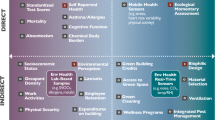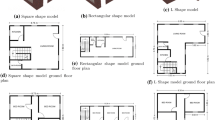Abstract
Natural ventilation strategies as effective low energy refurbishment solutions are identified within this research study, for an existing urban multi-storey apartment building in Athens, representative of over four-million Greek urban residential buildings. Retrofit strategies were evaluated using occupant comfort criteria and the existing ventilation strategy, for a single apartment using dynamic thermal simulations. These strategies included individual day and night ventilation, a wind-catcher and a dynamic façade. Suitable openings operation in response to environmental parameters provided sufficient day and night ventilation and occupant comfort. The inclusion of a wind-catcher yielded very little improvement to the ventilation performance. However, the combined operation of the wind-catcher and the dynamic façade delivered operative temperature reductions of up to 7 °C below the base-case strategy, and acceptable ventilation rates for up to 65% of the cooling period. The successful performance of the proposed strategies highlights their potential for reducing energy consumption and improving thermal comfort in a large number of buildings in hot climates.
Similar content being viewed by others
References
Androutsopoulos A, Aravantinos D, Gaglia A, Giannakidis C, Gidaki C, et al. (2012). Technical Directive Τ.Ο.Τ.Ε.Ε. 20701-1/2010. Detailed National Requirements of Parameters for Calculating the Energy Performance of Buildings and Issuing the Energy Performance Certificate, 2nd edn. Athens, Greece: Ministry of Environment, Energy and Climate Change-YPEKA, Technical Chamber of Greece TEE.
Argiriou A, Gaglia A, Daskalaki E, Zaharias P, Katsanos D, et al. (2010). Technical Directive Τ.Ο.Τ.Ε.Ε. 20701-3/2010 Climate data of Greek Cities. Athens, Greece: Ministry of Environment, Energy and Climate Change-YPEKA, Technical Chamber of Greece TEE.
ASHRAE (2013). ANSI/ASHRAE Standard 62.1-2013. Ventilation for Acceptable Indoor Air Quality, Atlanta, USA: American Society of Heating, Refrigerating and Air-conditioning Engineers.
Asimakopoulos DA, Santamouris M, Farrou I, Laskari M, Saliari M, et al. (2012). Modelling the energy demand projection of the building sector in Greece in the 21st century. Energy and Buildings, 49: 488–498.
Attia S, Beltrán L, Herde AD, Hensen J (2009). Architect Friendly: A comparison of ten different building performance simulation tools. In: Proceedings of the 11the International IBPSA Building Simulation Conference, Glasgow, UK, pp. 204–211.
BS EN15251 CEN (2007). Indoor Environmental Input Parameters for Design and Assessment of Energy Performance of Buildings Addressing Indoor Air Quality, Thermal Environment, Lighting and Acoustics. London: British Standards Institute (BSI).
Calautit JK, Hughes BR, Ghani SA (2013). A numerical investigation into the feasibility of integrating green building technologies into row houses in the Middle East. Architectural Science Review, 56: 279–296.
Cândido C, Lamberts R, de Dear R, Bittencourt L, de Vecchi R (2011). Towards a Brazilian standard for naturally ventilated buildings: Guidelines for thermal and air movement acceptability. Building Research & Information, 39: 145–153.
CIBSE (2005). CIBSE Guide B. Heating, Ventilating, Air Conditioning and Refrigeration. London, UK.
CIBSE (2006). CIBSE Guide A. Environmental Design. London, UK.
ClimateConsultant (2014). Climate Consultant. Software Version 5.5 (build 5), free licence. University of California, Los Angeles, USA.
Cóstola D, Blocken B, Hensen JLM (2009). Overview of pressure coefficient data in building energy simulation and airflow network programs. Building and Environment, 44: 2027–2036.
Drakou A, Tsangrassoulis A, Roetzel A (2011). Occupant interaction with the interior environment in Greek dwellings during summer. In: Proceedings of the 27th Conference on Passive and Low Energy Architecture (Plea 2011), Louvain-la-Neuve, Belgium, pp. 475–480.
EL.STAT. (2014). Statistical Database, Hellenic Statistical Authority (EL.STAT.). Available at http://www.statistics.gr.
Elmualim AA (2006). Verification of design calculations of a wind catcher/tower natural ventilation system with performance testing in a real building. International Journal of Ventilation, 4: 393–404.
Eurostat (2016). Eurostat—Your key to European statistics. Europian Commission. Available at http://ec.europa.eu/eurostat/web/energy/data/main-tables. Accessed 16 Jun 2016.
Georgakis C, Santamouris M (2006). Experimental investigation of air flow and temperature distribution in deep urban canyons for natural ventilation purposes. Energy and Buildings, 38: 367–376.
Geros V, Santamouris M, Tsangrasoulis A, Guarracino G (1999). Experimental evaluation of night ventilation phenomena. Energy and Buildings, 29: 141–154.
Givoni B (1994). Passive and Low Energy Cooling of Buildings. New York: Van Nostrand Reinhold.
GOK (1985). General Construction Regulation of Greece Article 11 and 16. available at http://portal.tee.gr. (in Greek)
Hamza N (2008). Double versus single skin facades in hot arid areas. Energy and Buildings, 40: 240–248.
IES VE (2012). Virtual Environment, Software, Version 6.4.0.11, student licence. Integrated Environmental Solutions Ltd. Available at http://www.iesve.com.
IES VE (n.d.). MacroFlo Opening Types User Guide [Internet]. Available at http://www.iesve.com/downloads/help/Thermal/MacroFloOpeningTypes.pdf.
Kapsomenakis J, Kolokotsa D, Nikolaou T, Santamouris M, Zerefos SC (2013). Forty years increase of the air ambient temperature in Greece: The impact on buildings. Energy Conversion and Management, 74: 353–365.
Koukousianos S (2011). Meteorological Station of Galatsi. Available at http://galatsi.meteoclub.gr. Accessed 11 Jan 2013.
Mavrogianni A, Davies M, Taylor J, Chalabi Z, Biddulph P, Oikonomou E, Das P, Jones B (2014). The impact of occupancy patterns, occupant-controlled ventilation and shading on indoor overheating risk in domestic environments. Building and Environment, 78: 183–198.
McCartney KJ, Fergus Nicol J (2002). Developing an adaptive control algorithm for Europe. Energy and Buildings, 34: 623–635.
Meteonorm 7 (2012). Software, version 7 (Meteotest), Bern, Switzerland.
Niachou K, Hassid S, Santamouris M, Livada I (2005). Comparative monitoring of natural, hybrid and mechanical ventilation systems in urban canyons. Energy and Buildings, 37: 503–513.
Nicol F, Humphreys M (2010). Derivation of the adaptive equations for thermal comfort in free-running buildings in European standard EN15251. Building and Environment, 45: 11–17.
O’Sullivan PD, Kolokotroni M (2014). Time-averaged single sided ventilation rates and thermal environment in cooling mode for a low energy retrofit envelope. International Journal of Ventilation, 13: 153–168.
Palmero-Marrero AI, Oliveira AC (2010). Effect of louver shading devices on building energy requirements. Applied Energy, 87: 2040–2049.
Papadopoulos AM, Oxizidis S, Papathanasiou L (2008). Developing a new library of materials and structural elements for the simulative evaluation of buildings’ energy performance. Building and Environment, 43: 710–719.
Papakostas KT, Sotiropoulos BA (1997). Occupational and energy behaviour patterns in Greek residences. Energy and Buildings, 26: 207–213.
Papamanolis N (2000). Natural ventilation as a design factor in buildings in Greece. Architectural Science Review 43(4): 175–182.
Papamanolis N (2015). The first indications of the effects of the new legislation concerning the energy performance of buildings on renewable energy applications in buildings in Greece. International Journal of Sustainable Built Environment, 4: 391–399.
Prajongsan P, Sharples S (2012). Enhancing natural ventilation, thermal comfort and energy savings in high-rise residential buildings in Bangkok through the use of ventilation shafts. Building and Environment, 50: 104–113.
Psomas T, Holzer P, Santamouris M (2014). A naturally ventilated efficient residential building under the impact of climate change. International Journal of Ventilation, 13: 169–178.
Sakka A, Wagner A, Santamouris M (2010). Thermal comfort and occupant satisfaction in residential buildings—Results of field study in residential buildings in Athens during the summer period. In: Proceeding of Adapting to Change: New Thinking on Comfort, Windsor, UK.
Santamouris M, Argiroudis K, Georgiou M, Livada I, Doukas P, Assimakopoulos M, Sfakianaki A, Pavlou K, Geros V, Papaglastra M (2007a). Indoor air quality in fifty residences in Athens. International Journal of Ventilation, 5: 367–380.
Santamouris M, Kapsis K, Korres D, Livada I, Pavlou C, Assimakopoulos MN (2007b). On the relation between the energy and social characteristics of the residential sector. Energy and Buildings, 39: 893–905.
Santamouris M, Papanikolaou N, Livada I (2001). On the impact of urban climate on the energy consumption of buildings. Solar Energy, 70: 201–216.
Santamouris M, Sfakianaki A, Pavlou K (2010). On the efficiency of night ventilation techniques applied to residential buildings. Energy and Buildings, 42: 1309–1313.
Spentzou E (2015). Refurbishment of apartment buildings in the Mediterranean Region for natural ventilation: Implications for building design. PhD Thesis, Loughborough University Loughborough UK.
Spentzou E, Cook JM, Emmitt S (2013). Enhancing indoor comfort in existing apartment buildings in Athens using natural ventilation. In: Proceedings of the 13th Conference of International IBPSA Building Simulation Conference, Chambéry, France, pp. 1168–1175.
Spentzou E, Cook JM, Emmitt S (2017). Modelling natural ventilation for summer thermal comfort in Mediterranean dwellings. International Journal of Ventilation, doi: 10.1080/14733315.2017.1302658.
Theodoridou I, Papadopoulos AM, Hegger M (2011). A typological classification of the Greek residential building stock. Energy and Buildings, 43: 2779–2787.
Yun GY, Steemers K (2011). Behavioural, physical and socio-economic factors in household cooling energy consumption. Applied Energy, 88: 2191–2200.
Author information
Authors and Affiliations
Corresponding author
Rights and permissions
About this article
Cite this article
Spentzou, E., Cook, M.J. & Emmitt, S. Natural ventilation strategies for indoor thermal comfort in Mediterranean apartments. Build. Simul. 11, 175–191 (2018). https://doi.org/10.1007/s12273-017-0380-1
Received:
Revised:
Accepted:
Published:
Issue Date:
DOI: https://doi.org/10.1007/s12273-017-0380-1




